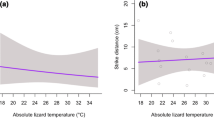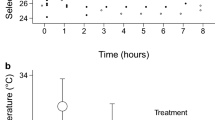Abstract
Rattlesnakes use their facial pit organs to sense external thermal fluctuations. A temperature decrease in the heat-sensing membrane of the pit organ has the potential to enhance heat flux between their endothermic prey and the thermal sensors, affect the optimal functioning of thermal sensors in the pit membrane and reduce the formation of thermal “afterimages”, improving thermal detection. We examined the potential for respiratory cooling to improve strike behaviour, capture, and consumption of endothermic prey in the South American rattlesnake, as behavioural indicators of thermal detection. Snakes with a higher degree of rostral cooling were more accurate during the strike, attacking warmer regions of their prey, and relocated and consumed their prey faster. These findings reveal that by cooling their pit organs, rattlesnakes increase their ability to detect endothermic prey; disabling the pit organs caused these differences to disappear. Rattlesnakes also modify the degree of rostral cooling by altering their breathing pattern in response to biologically relevant stimuli, such as a mouse odour. Our findings reveal that low humidity increases their ability to detect endothermic prey, suggesting that habitat and ambush site selection in the wild may be influenced by external humidity levels as well as temperature.





Similar content being viewed by others
References
Amemiya F, Nakano M, Goris RC, Kadota T, Atobe Y, Funakoshi K, Hibiya K, Kishida R (1999) Microvasculature of crotaline snake pit organs: possible function as a heat exchange mechanism. Anat Rec 254:107–115
Andrade DV, Tattersall GJ, Brito SP, Soncini R, Branco LG, Glass ML, Abe AS, Milsom WK (2004) The ventilatory response to environmental hypercarbia in the South American rattlesnake, Crotalus durissus. J Comp Physiol B 174:281–291
Bleichmar H, De Robertis E (1962) Submicroscopic morphology of the infrared receptor of pit vipers. Z Zellforsch Mikrosk Anat 56:748–761
Borrell BJ, LaDuc TJ, Dudley R (2005) Respiratory cooling in rattlesnakes. Comp Biochem Physiol A 140:471–476
Brock OG (1980) Predatory behavior of eastern diamondback rattlesnake (Crotalus adamanteus): field enclosure and Y-maze laboratory studies, emphasizing prey trailing behaviors. Florida State University, Tallahassee
Bullock TH, Cowles RB (1952) Physiology of an infrared receptor: the facial pit of pit vipers. Science 115:541–543
Bullock TH, Diecke FPJ (1956) Properties of an infra-red receptor. J Physiol 134:47–87
Bullock TH, Fox W (1957) The anatomy of the infra-red sense organ in the facial pit of pit vipers. Quar J Micro Sci 98:219–234
Chiszar D, Radcliffe CW, Scudder KM (1977) Analysis of behavioral sequence emitted by rattlesnakes during feeding episodes. 1. Striking and chemosensory searching. Behav Biol 21:418–425
Chiszar D, Simonsen L, Radcliffe C, Smith HM (1979) Rate of tongue flicking by cottonmouths (Agkistrodon piscivorus) during prolonged exposure to various food odors, and strike-induced chemosensory searching by the cantil. Trans Kan Acad Sci 82:49–54
Chiszar D, Lee RK, Radcliffe CW, Smith HM (1992) Searching behaviors by rattlesnakes following predatory strikes. In: Campbell JA, Brodie ED (eds) Biology of the Pitvipers. Selva, Tyler, pp 199–216
Clarke JA, Chopko JT, Mackessy SP (1996) The effect of moonlight on activity patterns of adult and juvenile prairie rattlesnakes (Crotalus viridis viridis). J Herpetol 30:192–197
de Cock Buning TD (1983a) Thermal sensitivity as a specialization for prey capture and feeding in snakes. Am Zool 23:363–375
de Cock Buning TD (1983b) Thresholds of infrared-sensititive tectal neurons in Python reticulatus, Boa constrictor and Agkistrodon rhodostoma. J Comp Physiol A 151:461–467
de Cock Buning TD (1984) A theoretical approach to the heat sensitive pit organs of snakes. J Theor Biol 111:509–529
de Cock Buning T, Goris RC, Terashima S (1981) The role of thermosensitity in the feeding behavior of the pit viper Agkistrodon blomhoffi brevicaudus. Japan J Herpetol 9:7–27
Ebert J, Westhoff G (2006) Behavioural examination of the infrared sensitivity of rattlesnakes (Crotalus atrox). J Comp Physiol A 192:941–947
Ebert J, Schmitz A, Westhoff G (2006) Surface structure of the infrared sensitive pits of the boa Corallus hortulanus. In: Vences M, Köhler T, Ziegler T, Böhme W (eds) Herpetologia Bonnensis II Proceedings of the 13th Congress of the Societas Europaea Herpetologica, 2006, pp 215–217
Ebert J, Muller S, Westhoff G (2007) Behavioural examination of the infrared sensitivity of ball pythons. J Zool 272:340–347
Estep K, Poole T, Radcliffe CW, Oconnell B, Chiszar D (1981) Distance traveled by mice after envenomation by a rattlesnake (C. viridis). Bull Psych Soc 18:108–110
Goris RC, Terashim S (1973) Central response to infrared stimulation of pit receptors in a crotaline snake, Trimeresurus flavoviridis. J Exp Biol 58:59–76
Goris RC, Atobe Y, Nakano M, Hisajima T, Funakoshi K, Kadota T (2003) The microvasculature of python pit organs: morphology and blood flow microkinetics. Microvas Res 65:179–185
Grace MS, Woodward OM, Church DR, Calisch G (2001) Prey targeting by the infrared-imaging snake Python: effects of experimental and congenital visual deprivation. Behav Brain Res 119:23–31
Gracheva E, Ingolia N, Kelly Y, Cordero-Morales J, Hollopeter G, Chesler A, Sanchez E, Perez J, Weissman J, Julius D (2010) Molecular basis of infrared detection by snakes. Nature 464:1006–1066
Haverly JE, Kardong KV (1996) Sensory deprivation effects on the predatory behavior of the rattlesnake, Crotalus viridis oreganus. Copeia 419–428
Hayes WK, Hayes DM (1993) Stimuli influencing the release and aim of predatory strikes of the Northern Pacific Rattlesnake, Crotalus v. viridis. Northwestern Naturalist 74:1–9
Kardong KV (1992) Proximate factors affecting guidance of the rattlesnake strike. Zool Jahrb Anat 122:233–244
Kardong KV, Berkhoudt H (1999) Rattlesnake hunting behavior: correlations between plasticity of predatory performance and neuroanatomy. Brain Behav Evol 53:20–28
Kardong KV, Mackessy SP (1991) The strike behavior of a congenitally blind rattlesnake. J Herpetol 25:208–211
Krochmal AR, Bakken GS (2003) Thermoregulation is the pits: use of thermal radiation for retreat site selection by rattlesnakes. J Exp Biol 206:2539–2545
Krochmal AR, Bakken GS, LaDuc TJ (2004) Heat in evolution’s kitchen: evolutionary perspectives on the functions and origin of the facial pit of pitvipers (Viperidae:Crotalinae). J Exp Biol 207:4231–4238
Lee RKK, Chiszar DA, Smith HM (1988) Post-strike orientation of the prairie rattlesnake facilitates location of envenomated prey. J Ethol 6:129–134
Lee RKK, Chiszar DA, Smith HM, Kandler K (1992) Chemical and orientational cues mediate selection of prey trails by Prairie Rattlesnakes (Crotalus viridis). J Herpetol 26:95–98
Molenaar GJ (1992) Anatomy and physiology of infrared sensitivity of snakes. In: Gans C, Ulinski PS (eds) Biology of the Reptilia, vol 17. University of Chicago Press, Chicago, pp 367–453
O’Connell B, Chiszar D, Smith HM (1983) Strike-induced chemosensory searching in prairie rattlesnakes (Crotalus viridis) during daytime and at night. J Herpetol 17:193–196
Pappas TC, Motamedi M, Christensen BN (2004) Unique temperature-activated neurons from pit viper thermosensors. Am J Physiol Cell Physiol 287:C1219–C1228
Robertshaw D (2006) Mechanisms for the control of respiratory evaporative heat loss in panting animals. J Appl Physiol 101:664–668
Schmidt DF, Hayes WK, Hayes FE (1993) The influence of prey movement on the aim of predatory strikes in the rattlesnake, Crotalus viridis. Great Basin Naturalist 53:203–206
Tattersall GJ, Milsom WK, Abe AS, Brito SP, Andrade DV (2004) The thermogenesis of digestion in rattlesnakes. J Exp Biol 207:579–585
Tattersall GJ, Cadena V, Skinner MC (2006) Respiratory cooling and thermoregulatory coupling in reptiles. Resp Physiol Neurobiol 154:302–318
Van Dyke JU, Grace MS (2010) The role of thermal contrast in infrared-based defensive targeting by the copperhead, Agkistrodon contortrix. Anim Behav 79:993–999
Vollmer M, Möllmann K-P (2010) Infrared thermal imaging fundamentals, research and applications. Wiley-VCH, Weinheim
Westhoff G, Morsch M, Ebert J (2006) Infrared detection in the rattlesnake Crotalus atrox—from behavioural studies to midbrain recordings. In: Vences M, Köhler T, Ziegler T, Böhme W (eds) Herpetologia Bonnensis II Proceedings of the 13th Congress of the Societas Europaea Herpetologica, pp 225–228
Acknowledgments
This research was supported by grants from the Fundação de Amparo a Pesquisa do Estado de São Paulo (FAPESP), Conselho Nacional de Desenvolvimento Científico e Tecnológico (CNPq), and Fundação para o Desenvolvimento da Unesp (FUNDUNESP) to DVA, the NSERC of Canada to GJT, and a Journal of Experimental Biologists Travelling Fellowship to VC. Approval to perform the animal studies was issued by the Commission for Ethics in Animal Experimentation from University of São Paulo State (UNESP), SP, Brazil, Protocol Numbers: 03/08-CEEA and 021/2010. We thank Augusto S. Abe for facilitating laboratory logistics, Laura Aedy for assistance with analysis of thermal images, and William Hayes for his critical feedback on the manuscript.
Author information
Authors and Affiliations
Corresponding author
Rights and permissions
About this article
Cite this article
Cadena, V., Andrade, D.V., Bovo, R.P. et al. Evaporative respiratory cooling augments pit organ thermal detection in rattlesnakes. J Comp Physiol A 199, 1093–1104 (2013). https://doi.org/10.1007/s00359-013-0852-4
Received:
Revised:
Accepted:
Published:
Issue Date:
DOI: https://doi.org/10.1007/s00359-013-0852-4




